Imagine you’re in one of my five-day classes. You’ve chosen an ambitious project: a fabric collage portrait of an important person in your life.
But this is day two of the class. You’ve learned some stuff:
- You can use glue with fabric.
- You’re beginning to understand how value determines form.
- You’ve chosen a great photo to work from and have created a design on which to base your fabric collage quilt.
You have the start of a cheek, maybe a chin. Or perhaps you began with the hair. Or even the clothing.
You haven’t yet got to the scary parts. The eyes. The nose and ears and mouth. The parts that will really identify the person your portraying. Those features are just waiting for you to lay scissors to fabric.
Where do you start? You don’t know?
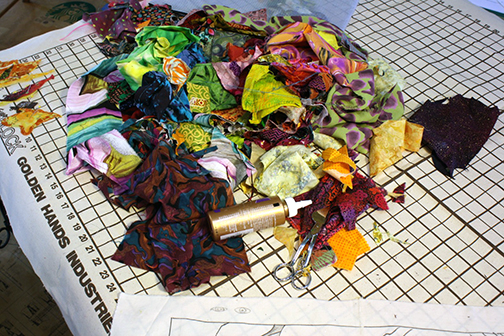
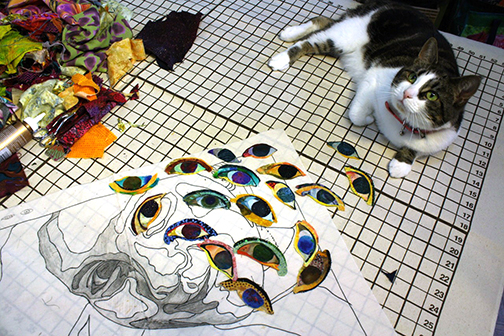
This is about the point at which I’ll stop the class and do a quick demo. In a fifteen-minute tutorial, I show my students a technique that allows them to create features such as eyes with minute detail and while sticking precisely to their designs. And all without the use of a template. That would take too long.
I sometimes describe it as working top-down from the bottom-up.
Top-Down, Bottom-Up
Let’s take the example I use in class. I have a design I made based on a photo of my niece, Maia.
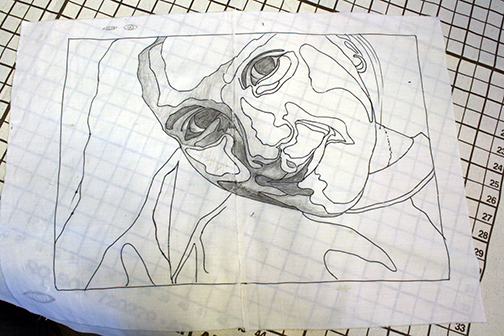
I’m going to concentrate on her left eye.
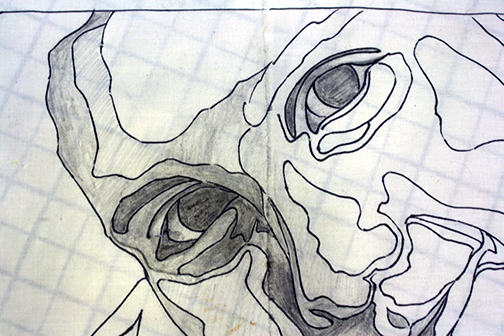
The temptation is to start with the biggest part of the eye maybe even the eyelids, and add fabric on top of that—building up. This temptation is especially strong for those used to working with templates. This technique I’m describing here I believe is both quicker and easier.
Step One
Instead of starting with the biggest area of the eye, I start with the smallest—the pupil. Actually, it’s the iris, but I tend to choose a fabric that’s either all dark (incorporating both pupil and iris) or has a darker area in the center (suggesting a pupil).
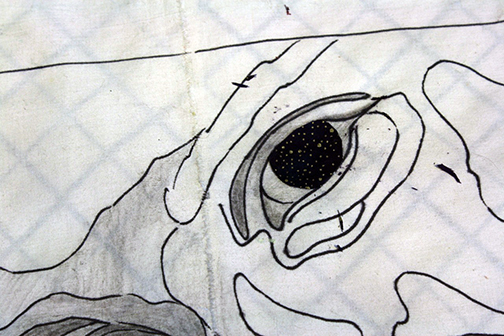
Above is the finished iris/pupil. How did I do it? Follow the steps in the slideshow below. Hovering over a slide reveals descriptive captions. Clicking on one will launch a slideshow with larger pictures.
I start by selecting a dark fabric. This time I chose one with some sparkle in it. I then used my pelican-bladed applique scissors to first roughly, then exactly trim the pupil to shape.
Step One done. Easy-peasy.
Step Two
Now I’m ready to move on to the “white” of the eye. Very rarely is the white of the eye white. A little variation of shading will make it look more realistic.
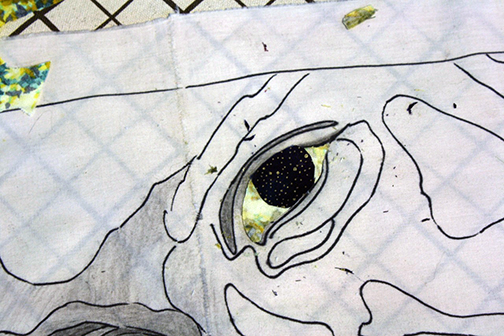
Based on the original photograph, I shaded the drawing to match, creating a sort of cheat sheet that will get covered up with every layer added. According to the pencil shading, the inner corner of her eye should be darker.
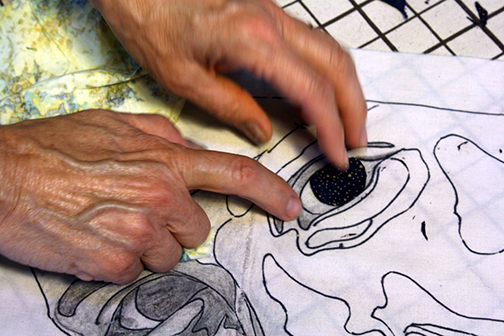
I’m going to use the print in the fabric to create both the light “white” of her eye, and that darker corner, with one cut of fabric. Check out the slides below to see how I choose that fabric and how it went together. In this sequence I’ll work each corner of the eye individually.
I choose the fabric by placing it under the iris, already cut to size. I place it so the print is positioned to best match the drawing.
Then, BEFORE I CUT, I glue the two pieces together, the iris onto the larger piece of uncut fabric.
Once the two are secured together, I carefully trim the fabric to match my drawn design and cut away some of the extra fabric from behind the iris that I don’t need.
This is what the back of the eye now looks like. Yes, I used the BACK of the print for the white of the eye. Sometimes it’s the backs of fabrics that work better for the desired effect.
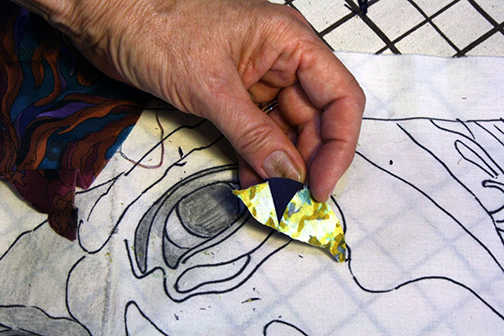
Step Three
It often looks good to add a dark line above the eye, like applying eyeliner. In contrast, a lighter line below the eye adds some life. I’ll tackle both those in the next step.
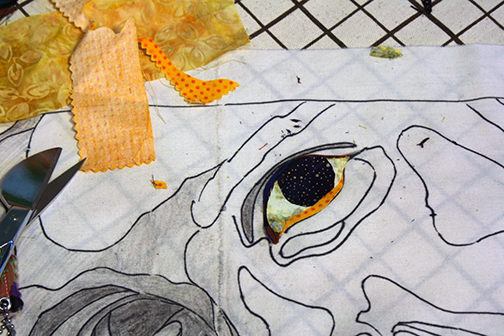
I’ll continue to use the same technique. First, I choose a dark fabric for the line above the eye. In this case, again, I look for interesting patterns in the print that mimic or accentuate the shape of the feature I’m working on. I attach the previously glued iris with its white corners to this new fabric. Then cut down and trim the fabric to shape.
Notice how fine I can make both the dark and light lines above and below the eye appear. All because they peak out from BEHIND the eye. No tiny little slivers of fabric needed and the eye unit is stable enough to pick up and move around.
The photo below shows what the back now looks like. All you can see are the back sides of the last two fabrics I used. Yes, the layers start building up. Don’t worry about it. The machine will quilt right through all that in the end. Unless you’re a hand quilter, and then you’re on your own.
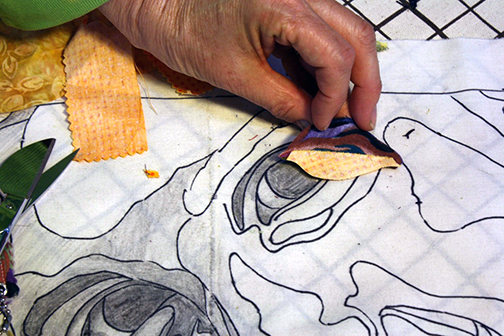
Step Four (more of the same, really)
I keep working outward. Now you can begin to see why I call it working top-down, bottom-up. In this step, I’ll add the upper eyelid and the crease under the eyebrow, enlarging the one portable, stable eye unit.
Notice that after I rough cut the newest fabric piece to shape, I often pick the unit up in order to trim the fabric more easily and get a smoother final cut. I’ll also trim away some of the extra fabric from the back, if I think of it.
And then you just keep going as long as you have those little shapes, lines, and creases to assemble. You could easily do the whole eye and socket as one unit.
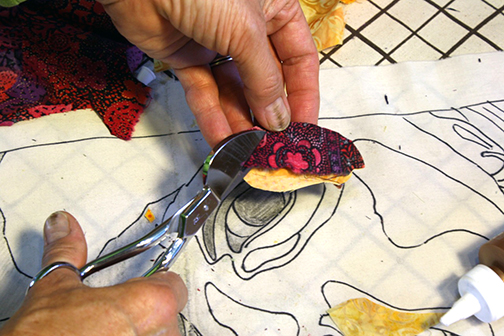
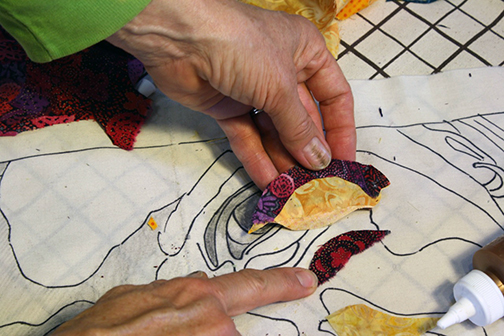
Other Features
Now that you’ve learned how to make an eye, do you see how this particular layering sequence can be applied to other facial features? How about lips?
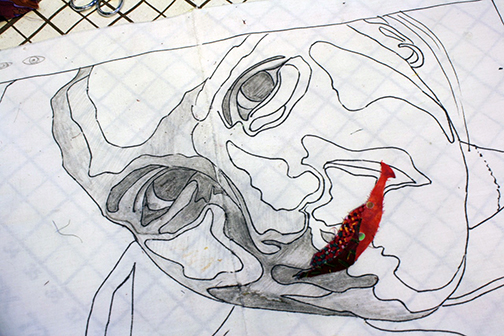
And it’s not just facial features. Any image that has small detailed areas can be broken down into parts: the windows and doors of a building (with their trim, highlights, and shadows), animal details (noses, claws, paws), car or truck parts (rear-view mirrors, tires, hubcap reflections), etc. etc.. But, back to eyes….
Windows
Real eyes have a ton of detail. There’s highlights and shadows, color, and shades of value. There’s a lot going on there. As there should be in such important facial features. And a fabric portrait will be most effective when it also reflects that complexity.
‘Cause that’s what it comes down to in the end. What you’re trying to accomplish. Your goal. Regardless of whether it looks “realistic,” your portrait should feel alive.
Eyes are the window to the soul. They’re also the window into your fabric collage portrait. Whether it’s a person or an animal, getting the eyes (and other features) right is especially important.
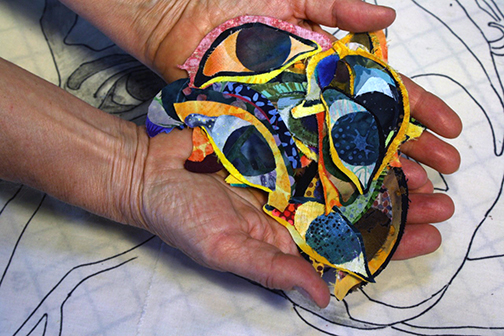














































Thank you so much…I was just about to cut out a zillion templates! One day when I am not a carer I will make it to one of your workshops. You are a very generous teacher. Sue
This is great – thank you.
I missed out on getting into your class at AQC last April, love your work!
Really appreciate how much you give in your blog.
Hope to do a class with you in Australia another time.
Chris
Thank you from all of us who love your work, but cannot get to one of your workshops. You have given great instructions on how to use your special technique of building a picture.
This is so great! A peek into how you create. Such an eye opener!
Susan, I always look forward to your posts. Thank you for sharing such great information. I can’t wait to take another one of your classes. Either in Asilomar or Arizona. 😊 Suzie Costantino
Sent from my iPad
>
This is such serendipity- I was just reading your book yesterday in preparation to starting a collage. The first thing I started to tackle was the eye and already feeling a little stuck! Thank you so much for this!
Thank you so much for taking the time to write this out and share it with us. It’s not only fabulous it takes away some of that anxiety of doing the eyes!!
Thank you so much for the great blogs and excellent information! I am so looking forward to taking one of your classes. I am wondering about the odd looking scissors you are using in the photos and what you like but them for this process. They look like it would be awkward to see when trimming small detail. I know that’s obviously not the case.
Dear Susan~
I see this on Facebook and share to save so I can look at it again. I’m imagining actually being able to take a class with you…it’s my dream! Then I check out my e-mail and realize I’ve got a subscription with you and voila! All the details in this great tutorial are actually in my mailbox. *Beams a big smile*
Thank you so much for making it possible for me to learn your techniques too. Very creative, inspiring and beautiful! ~Paula
On Sat, May 21, 2016 at 3:06 AM, Susan Carlson Quilts wrote:
> Susan posted: “Imagine you’re in one of my five-day classes. You’ve chosen > an ambitious project: a fabric collage portrait of an important person in > your life. But this is day two of the class. You’ve learned some stuff: You > can use glue with fabric. You’re beginnin” >
This was a great tutorial on your technique. The pictures and explanations were so detailed that I actually think I could do it? Am I kidding myself? I look forward to taking a class from you someday. Thank you so much.
Thanks for the generous details! Amazing yet effective; can’t wait to try this!
Thank you for this fabulous blog. You are so generous to share your knowledge.
What a great tutorial of what you do. Fascinating and inspiring..TY
Thanks for sharing, can’t wait to try this method!
Amazing eye tutorial. Thank you!
You are such an inspiration! Thank you for sharing your techniques and encouraging my creativity! I applaud you!
Thanks so much ! Great tutorial on your collage techniques. I love your book.
Thank you so much for the inspiration and knowledge you are freely giving out. This is exactly what I needed to push me in the direction of trying an art quilt picture of my ‘grand dogs’. I had no idea how to go about doing the eyes. Thanks again for taking the time to do this.
Thanks for sharing this detail! You are such a great artist! Love your work! Hope to take a class from you one day.
Thanks so much for the comprehensive and clear tutorial on how you approach making eyes. This really simplifies what could otherwise be a daunting process. I’m almost finished with a close up portrait of a cow (in shades of purple, of course!). Her eyes turned out okay–but I sure wish i had been armed with the expert knowledge from your tutorial before I started out. I’m sure they would have been even better. Thanks again for generously sharing your techniques and approaches with us.
That’s right. One advantage of this technique is that it’s never too late to make a change.
Since you are not thrilled with your cow eyes, couldn’t you make the eye units and glue them on top? Or maybe you are too far along. I took a class with Susan recently and glued fabric over some areas that’s weren’t working well. There are so many layers anyway it’s not even noticeable.
Eye love this tutorial! I have read this several times, so I have it in my quilt arsenal when needed. Thank you!
Love you eyes! Wish you had a Pinterest link, so I could remember where I saw how you do them.
Gee whiz, I already have so much online stuff. But you’re not the first to mention Pinterest. I may have to reconsider.
I have done numerous portrait quilts and am always looking for vast ways to improve areas that need improvement. I can’t thank you enough for this tutorial.
I have 2 questions, well many but I’ll keep it to just 2. Do you ever have issues with fraying? Do you straight stitch over piece when done? Melissa
No trouble with fraying, but then I don’t really mind frayed edges in most cases. Yes I quilt using a straight stitch in a stipple or squiggle pattern overall. I don’t try to catch each edge. I let the glue do some of the work.
Thank you for your answer Susan. I also noticed that you use tulle. It appears that you use this as high light and low lights but not all over the quilt, is this correct?
Thank you Susan for this tutorial. Your blog posts are so informative and inspiring. I hope some day to take a class with you.
I have heard .. read .. saw somewhere to always do the eyes first. “If the eyes don’t work, nothing will work.” What is your take on that?
I’ve never heard that. But it sounds as if it has at least a grain of truth. I often start with the eyes because they are so interesting.
Thank you Susan for this tutorial. Your blog posts are so informative and inspiring. I hope some day to take a class with you.
I have heard .. read .. saw somewhere to always do the eyes first. “If the eyes don’t work, nothing will work.” What is your take on that?
I’ve never heard that. But it sounds as if it has at least a grain of truth. I often start with the eyes because they are so interesting.
I’ve never heard that. But it sounds as if it has at least a grain of truth. I often start with the eyes because they are so interesting.